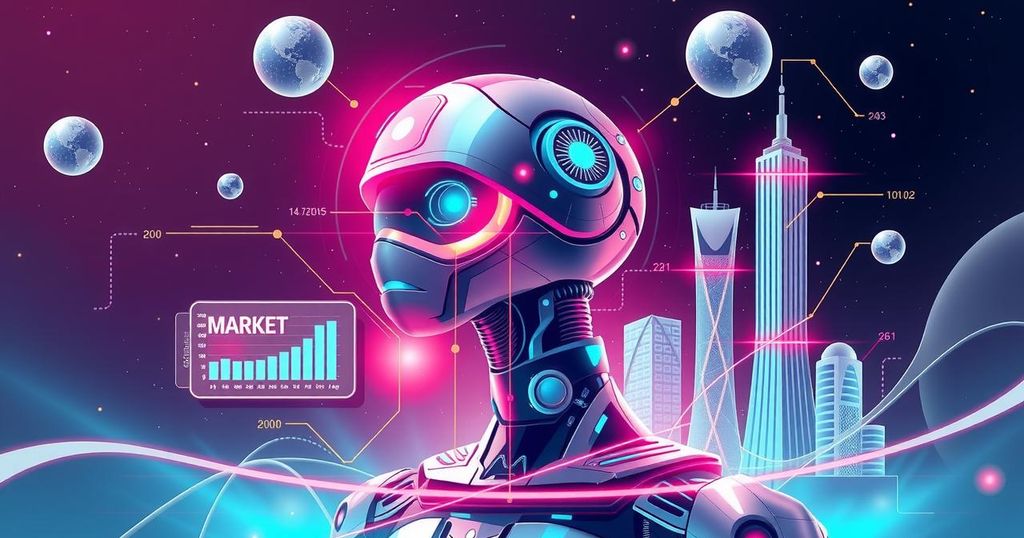The Enormous Future of Artificial Intelligence: Projected Growth and Trends
The global AI market is set to grow from USD 638.23 billion in 2024 to USD 3,680.47 billion by 2034, driven by North America’s robust demand and significant investments in Asia Pacific. The U.S. market will rise from USD 123.07 billion to an estimated USD 851.46 billion by 2034. Trends indicate challenges like talent shortages while the integration of AI in sectors like finance and healthcare will redefine operational excellence across industries.
In the vibrant landscape of technological advancement, the global Artificial Intelligence (AI) market is poised for unprecedented growth, expected to soar from USD 638.23 billion in 2024 to nearly USD 3,680.47 billion by 2034, reflecting a powerful CAGR of 19.1%. North America has firmly established itself as the frontrunner in this digital revolution, driven by robust demand from industries eager to integrate advanced AI solutions. The U.S. market alone is projected to grow significantly, highlighting a remarkable leap from USD 123.07 billion in 2023 to around USD 851.46 billion by 2034.
Meanwhile, Asia Pacific emerges as a dynamic player, quickly catching up with its innovative spirit and significant investments aimed at AI adoption across diverse sectors like healthcare and automotive. The rapid integration of AI technology in various fields is transforming operations, enabling businesses to optimize their workflows and enhance efficiencies. As quintessential markets like finance witness a paradigm shift with AI-driven solutions for trading and fraud detection, the need for transparency and skilled professionals becomes paramount. This ongoing technological metamorphosis brings forth challenges, as existing talent shortages could potentially hamper market expansion, but serves also as a catalyst for new entrants in the AI marketplace.
In the realm of deep learning and machine learning, where vast amounts of data are processed to uncover insights, the market is experiencing an exciting boom. Both hardware and software solutions are gaining traction, with an increasing demand for tailored AI services that simplify technology adoption. Companies are not just integrating AI but are discovering its potential by investing heavily in research and innovation, sculpting a future where machines collaborate seamlessly with human expertise,
This evolving narrative will shape industries far and wide, embedding AI into the very fabric of operational excellence. The response from end-users heralds a powerful call for AI compatibility in everything from medical devices to self-driving vehicles. The world is on the cusp of a technological renaissance, driven by the relentless pursuit of greater performance and efficiency through artificial intelligence.
The global AI market is rapidly shifting, as businesses and government initiatives promote the adoption of intelligent solutions across multiple sectors. With significant investments from industry-leading technology companies, AI is becoming a fundamental component in operations—from enhancing customer service in finance to increasing efficiencies in manufacturing. The development of cutting-edge infrastructures is key, but the growing recognition of talent shortages underscores the challenge of scaling this transformative technology effectively. As digitalization sweeps across industries, the pressure to leverage AI solutions increases, stimulating rapid advancements and creating a compelling narrative of technological integration.
As the AI market ascends to unprecedented heights, it weaves together the threads of innovation, demographic shifts, and a growing demand for intelligent solutions. The trajectory from USD 638.23 billion in 2024 to approximately USD 3,680.47 billion by 2034 is indicative of a massive transformation that touches every facet of life from finance to healthcare. While challenges such as talent shortages and the need for transparency persist, the collective efforts of global tech giants and emerging startups promise a future where intelligence ignites progress, underscoring the essence of collaboration between human ingenuity and artificial counterparts.
Original Source: www.precedenceresearch.com




Post Comment